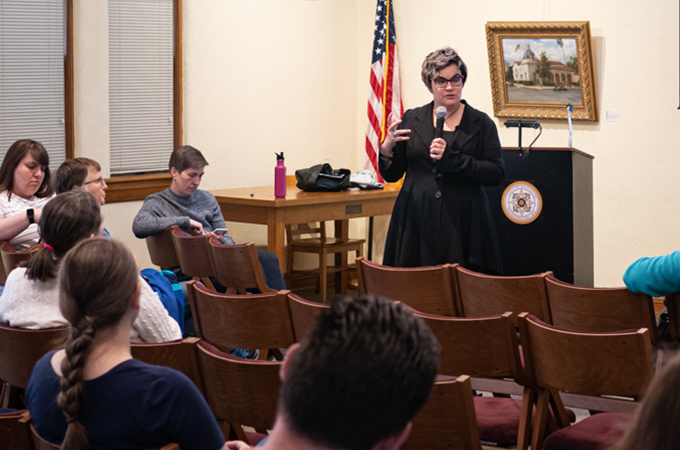Members of the Redlands community recently gathered at the A.K. Smiley Public Library to listen to University of Redlands Professor Kathy Feeley speak about the history of women’s suffrage 100 years after the passage of the 19th Amendment.
Before beginning her presentation, Feeley took time to acknowledge two audience members—councilwoman and Redlands Mayor Pro Tem Denise Davis ’08, for her intersectional, feminist leadership in local politics, and Brandon Alvarez ’20, who conducted the Redlands-specific research in Feeley’s lecture.
In her talk, titled “Securing the Vote: The History of Women’s Suffrage in Redlands and Across the Nation,” Feeley touched on the early days of the suffrage movement and how women in Redlands worked to form communities of like-minded “suffragists,” ultimately winning the right to vote first at the state and then at the national level.
Legal recognition
Eliminating the legal doctrine of coverture—the idea that married women live under their husband’s authority—was at the center of women’s rights communities and organizations. Coverture prevented women from having economic resources and independent political and legal voices.
“Coverture meant that, legally and politically, women were nonexistent,” said Feeley.
During the 1800s, married women’s property acts began to get passed, beginning to level the playing field between husband and wife when it came to property ownership, earnings, and other legal factors. In the wake of these changes, as well as organizing around the abolition of slavery and other social and political reforms, women’s suffrage became a popular form of activism.
“Suffrage was a form of activism in which a wide range of women—across class, race, ethnicity, religion, and region—engaged to enter the public sphere, secure full rights of citizenship, enter the professions and higher education, and secure a living wage,” said Feeley.
But equal status wasn’t necessarily extended to everyone in the movement. In 1890, the National American Women’s Suffrage Association (NAWSA) was formed and became the leading women’s suffrage organization. The membership of this organization, and others like it, skewed to white, upper-class women, who often enacted racist and classist policies to carry these organizations forward.
“African American, Chicanx, and other women with marginalized identities were mostly unwelcome in these national organizations, whether due to racism, xenophobia, and a mix of other factors,” said Feeley. Because of this, women of color across the country were tasked with creating their own suffrage organizations that ran parallel to those run by white women.
Significant inroads
The suffrage movement first began to make significant inroads in the Southwest. From 1869 to 1914, 12 states granted women the right to vote, including California, Arizona, Nevada, Utah, Washington, Oregon, Idaho, and Alaska. At the time, many of these states were newly formed and lacked a strong political infrastructure, making it easier to include women in state-wide legislation, rather than having to amend previously passed laws.
Because of this climate, membership to women’s clubs in the region grew rapidly with members who sought to work toward women’s suffrage legislation at the federal level. In Redlands, Mary Lynde Hoffman Craig, coeditor of The Citrograph newspaper, published a weekly column that documented the movement. One of the city’s most prominent suffragists, Mary E. Hamilton, was president of the American Association of University Women and vice president of the Women’s Political Equality League and hosted a number of important events in her home across the street from Prospect Park.
Between 1896 and 1911, women and men in Redlands organized an array of events, including teas, rallies, debates, and socials, aimed to spread the word about women’s right to vote. Two women’s organizations—the Contemporary Club and the Redlands chapter of the American Association of University Women—played a key role in suffrage activism and remain active today.
When the 19th Amendment was passed by Congress in 1919, ultimately giving women the right to vote nationally, a long fight began to get 36 states to ratify it, stretching into 1920.
“Even though one long battle was over,” said Feeley, “many categories of women—African American women, Native American women, Chicanx women, poor women, immigrant women—still faced many barriers to the vote, and their struggles continued. Barriers to the vote persist to this day. But the 19th Amendment made many things possible.”
Learn more about Feeley and studying history at the University of Redlands.






